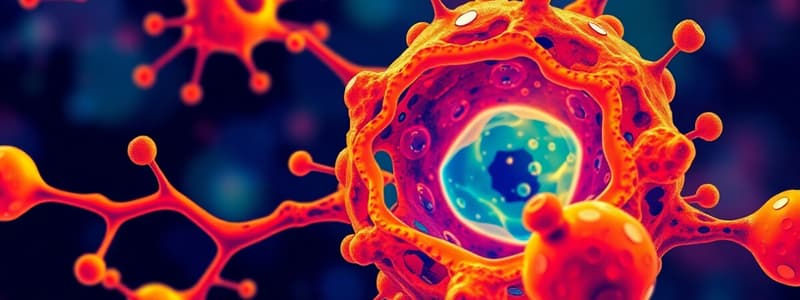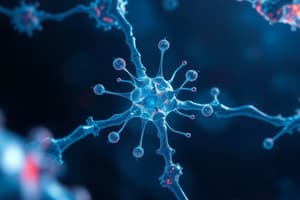Podcast
Questions and Answers
Which process directly converts DNA information into functional products?
Which process directly converts DNA information into functional products?
- Gene therapy
- Gene cloning
- Gene splicing
- Gene expression (correct)
What key mechanism of evolution selects for advantageous traits in a population?
What key mechanism of evolution selects for advantageous traits in a population?
- Gene flow
- Natural selection (correct)
- Genetic drift
- Artificial selection
What describes the variety of life forms within a particular area?
What describes the variety of life forms within a particular area?
- Ecosystem stability
- Population density
- Ecological succession
- Biodiversity (correct)
Which of the following organ systems is primarily responsible for gas exchange in humans?
Which of the following organ systems is primarily responsible for gas exchange in humans?
Which ecological interaction benefits one organism while harming another?
Which ecological interaction benefits one organism while harming another?
Which statement accurately describes a key difference between prokaryotic and eukaryotic cells?
Which statement accurately describes a key difference between prokaryotic and eukaryotic cells?
What is the primary function of the mitochondria in eukaryotic cells?
What is the primary function of the mitochondria in eukaryotic cells?
In what part of the cell does glycolysis occur during cellular respiration?
In what part of the cell does glycolysis occur during cellular respiration?
What is produced as a by-product of aerobic cellular respiration?
What is produced as a by-product of aerobic cellular respiration?
Which stage of photosynthesis is responsible for capturing light energy?
Which stage of photosynthesis is responsible for capturing light energy?
Which biological molecule primarily stores and transmits genetic information?
Which biological molecule primarily stores and transmits genetic information?
What role do lysosomes play within eukaryotic cells?
What role do lysosomes play within eukaryotic cells?
What is the role of chlorophyll in photosynthesis?
What is the role of chlorophyll in photosynthesis?
Flashcards
DNA function
DNA function
DNA stores genetic instructions for protein production, passed down through generations.
Natural Selection
Natural Selection
Adaptable traits make some living organisms more likely to survive and reproduce than others.
Gene Expression
Gene Expression
The process of converting genetic information into proteins.
Ecosystem Components
Ecosystem Components
Signup and view all the flashcards
Human Organ Systems
Human Organ Systems
Signup and view all the flashcards
Prokaryotic Cell
Prokaryotic Cell
Signup and view all the flashcards
Eukaryotic Cell
Eukaryotic Cell
Signup and view all the flashcards
Cellular Respiration
Cellular Respiration
Signup and view all the flashcards
Photosynthesis
Photosynthesis
Signup and view all the flashcards
Cell Membrane
Cell Membrane
Signup and view all the flashcards
Mitochondria
Mitochondria
Signup and view all the flashcards
Glycolysis
Glycolysis
Signup and view all the flashcards
Chloroplast
Chloroplast
Signup and view all the flashcards
Study Notes
Cell Structure and Function
- Cells are the basic units of life, exhibiting a wide range of shapes and sizes.
- Prokaryotic cells, like bacteria, lack a nucleus and other membrane-bound organelles.
- Eukaryotic cells, found in plants and animals, possess a nucleus and various organelles, each with specific functions.
- Key eukaryotic organelles include the nucleus, mitochondria (energy production), endoplasmic reticulum (protein synthesis and transport), Golgi apparatus (processing proteins), lysosomes (digestion), vacuoles (storage), and ribosomes (protein synthesis).
- Cell membranes regulate the passage of substances into and out of the cell, maintaining homeostasis.
- The cell wall, unique to plant cells, provides structural support.
Biological Molecules
- Carbohydrates (sugars) provide energy and structure.
- Lipids (fats) store energy, form cell membranes, and serve as hormones.
- Proteins perform diverse functions, including catalyzing reactions (enzymes), providing support, and transporting molecules.
- Nucleic acids (DNA and RNA) store and transmit genetic information.
- These molecules interact and combine to form complex structures and support biological processes.
Cellular Respiration
- Cellular respiration is the process by which cells break down glucose to release energy in the form of ATP (adenosine triphosphate).
- This process occurs in three main stages: glycolysis (occurs in the cytoplasm), the citric acid cycle (occurs in the mitochondrial matrix), and oxidative phosphorylation (occurs in the inner mitochondrial membrane).
- Cellular respiration requires oxygen and produces carbon dioxide as a by-product.
- The efficiency of cellular respiration is significantly impacted by oxygen availability, with anaerobic respiration producing considerably less ATP when oxygen is limited.
Photosynthesis
- Photosynthesis is the process by which plants and some other organisms convert light energy into chemical energy in the form of glucose.
- This process occurs in chloroplasts, specifically within the thylakoid membranes, where chlorophyll captures light energy.
- The process comprises two main stages: the light-dependent reactions (converting light energy into chemical energy) and the Calvin cycle (using the chemical energy to synthesize glucose).
- Photosynthesis is crucial for producing oxygen and is the primary source of energy for most ecosystems.
Genetics
- DNA (deoxyribonucleic acid) is the hereditary material that carries genetic instructions.
- DNA is organized into genes, which are segments of DNA that code for specific proteins.
- Genes are passed from parents to offspring, creating variations among individuals.
- Gene expression involves the conversion of genetic information from DNA to proteins.
- Mutations can occur in DNA, leading to alterations in genes and potentially affecting the organism.
- Basic Mendelian laws outline the principles of inheritance.
Evolution
- Evolution is the process of gradual change in the genetic makeup of populations over time.
- Natural selection is a key mechanism of evolution, where individuals with advantageous traits have a higher chance of survival and reproduction, passing those traits to their offspring.
- Genetic drift, mutations, and gene flow further contribute to evolution.
- Evolutionary relationships among organisms can be visualized using phylogenetic trees.
- Adaptations are traits that enhance survival and reproduction in a given environment.
Ecology
- Ecology studies the interactions between organisms and their environment.
- Populations, communities, ecosystems, and the biosphere represent different levels of ecological organization.
- Energy flow and nutrient cycling are essential components of ecosystems.
- Biodiversity describes the variety of life forms in a particular region.
- Organisms interact in various ways, including predation, competition, and symbiosis (mutualism, parasitism, commensalism).
Human Biology
- Human biology encompasses various aspects of human anatomy, physiology, and health.
- The human body is comprised of organ systems, each with specific functions.
- Concepts involving human genetics, nutrition, and disease are relevant topics.
- Various organ systems, including the digestive, respiratory, circulatory, nervous, endocrine, and immune systems, are important for human function.
Studying That Suits You
Use AI to generate personalized quizzes and flashcards to suit your learning preferences.
Description
This quiz covers the fundamental concepts of cell structure and function, including the differences between prokaryotic and eukaryotic cells. Additionally, it explores the roles and functions of various biological molecules, such as carbohydrates, lipids, and proteins. Test your knowledge on these essential topics in biology.




